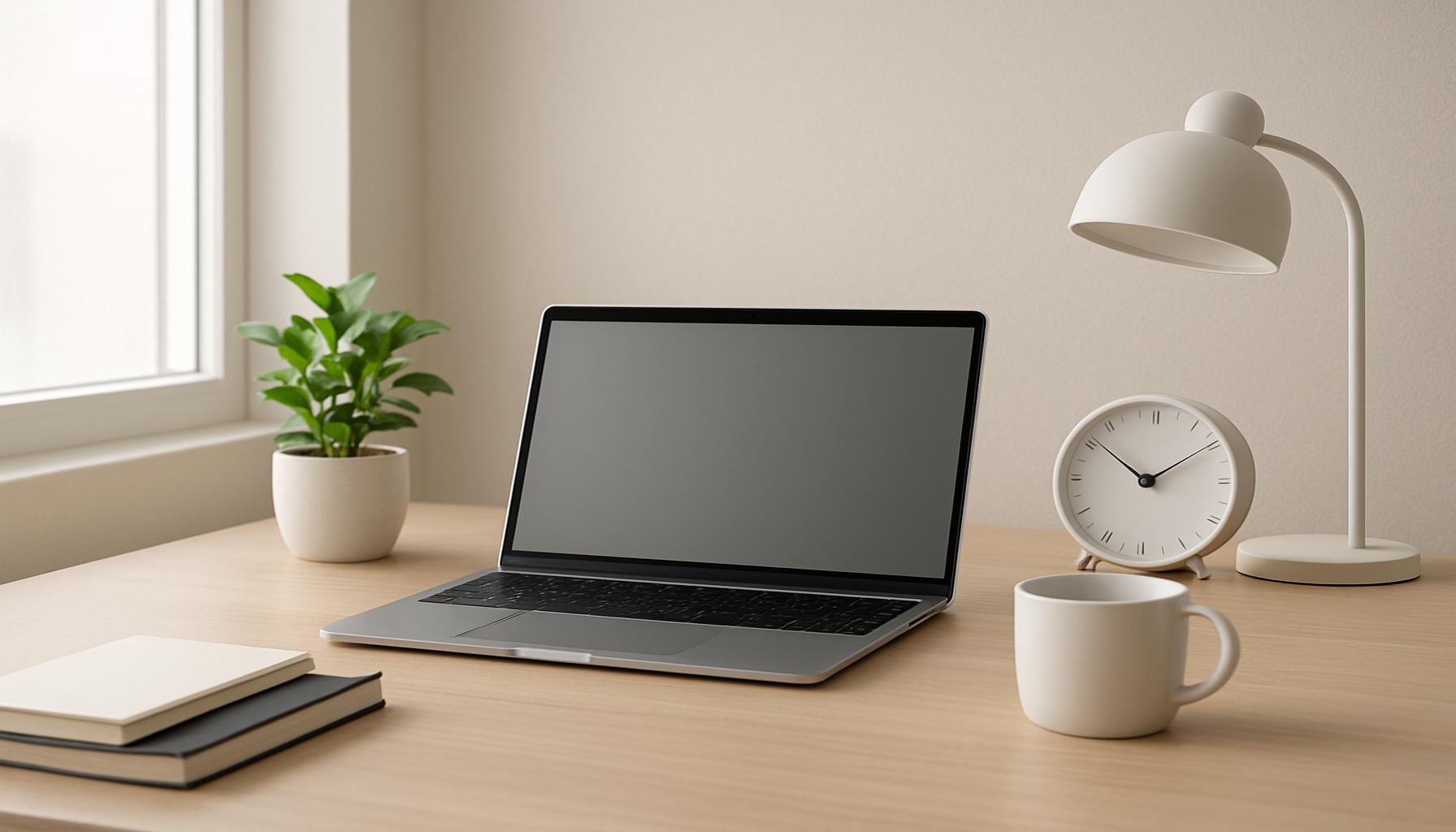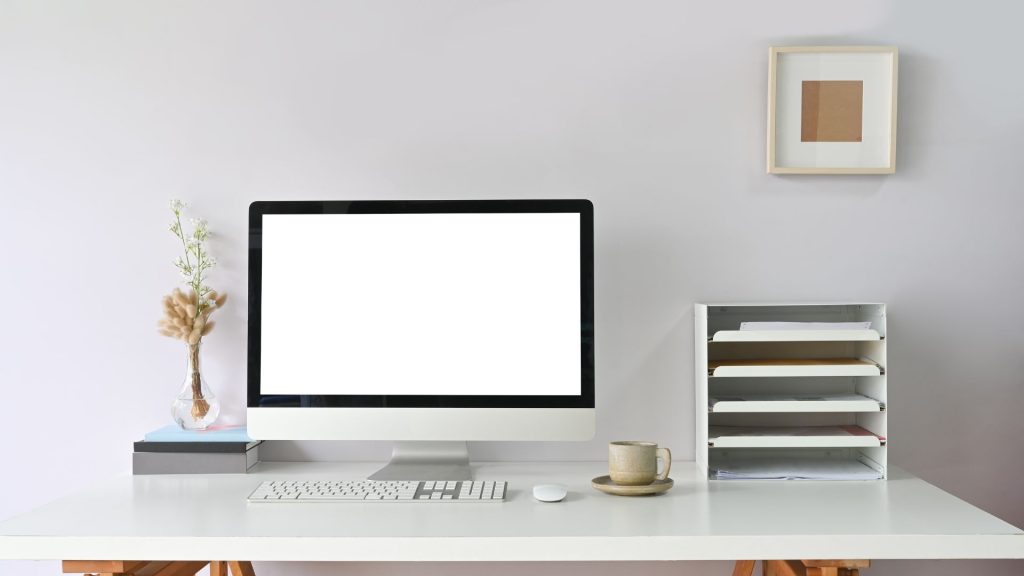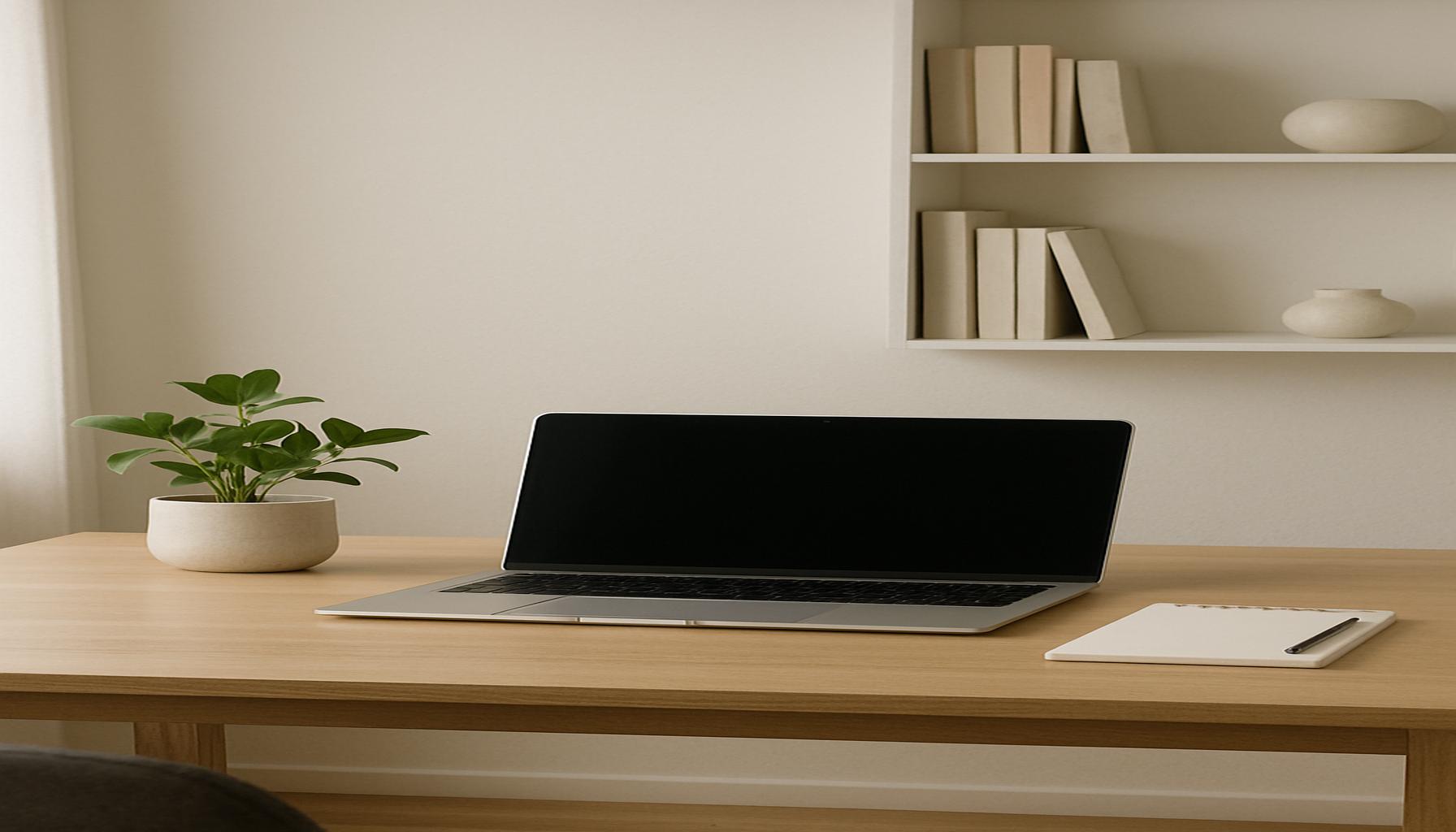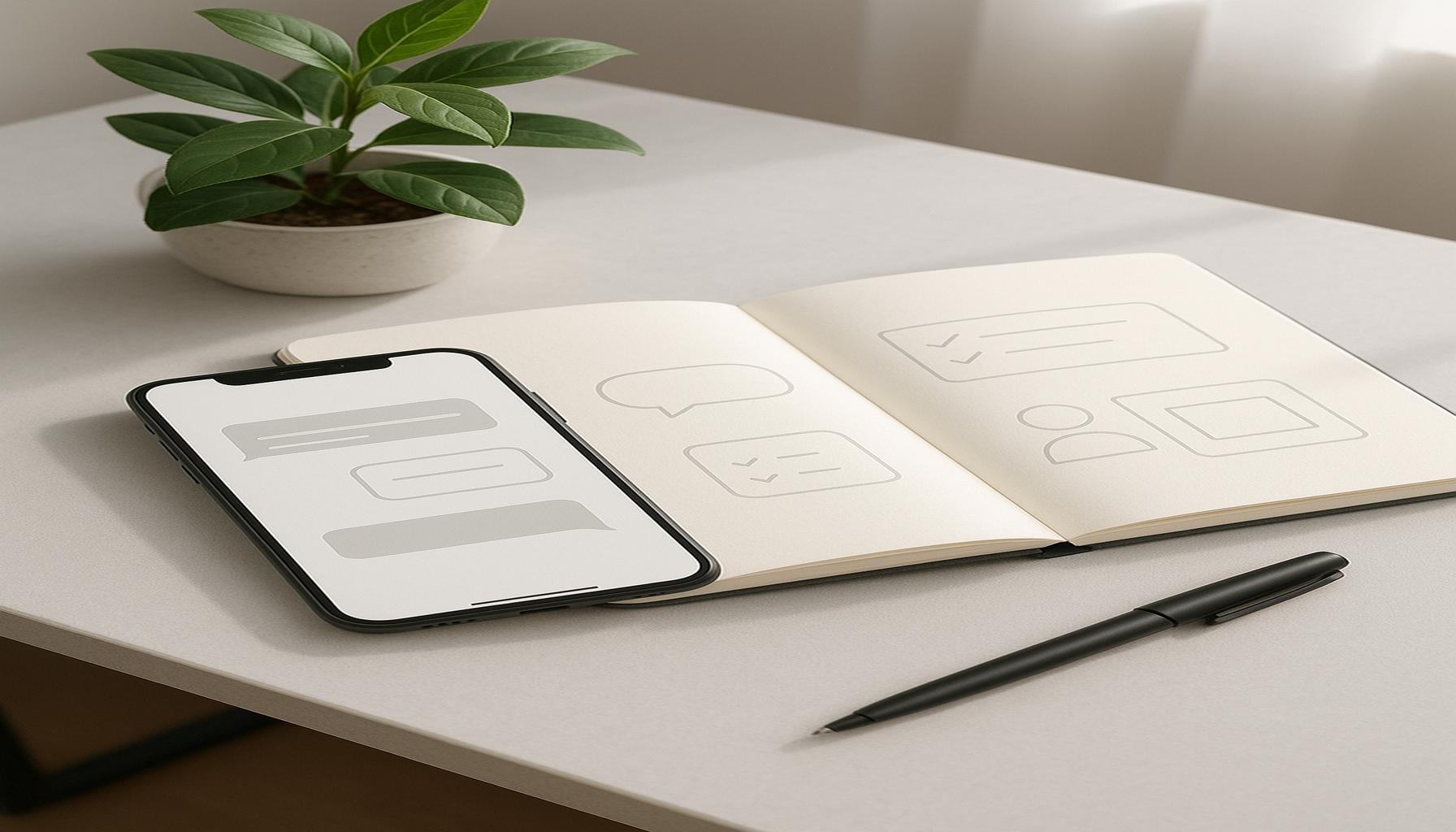Minimalist Strategies to Boost Workplace Efficiency Productivity

Introduction
In today’s fast-paced world, maintaining a streamlined and tidy workspace is more crucial than ever. Workspace clutter can significantly inhibit productivity, creating unnecessary stress and distractions. As the emphasis on minimalism grows, more individuals and businesses are embracing environments that prioritize simplicity and functionality. This shift goes beyond merely tidying up; it involves crafting a workspace that is both efficient and conducive to high performance.
Scientific research underscores the profound impact of our surroundings on our mental acuity and emotional health. A minimalist approach not only reduces distractions but also enhances creativity, promoting a serene work environment. This article will delve into five pivotal strategies for optimizing your workspace, all while aligning with minimalist principles.
Strategies for a Minimalist Workspace
- Assessing your current setup: Start by evaluating your existing workspace critically. Identify items that are essential versus those that can be removed or relocated. This initial assessment is crucial in creating a clear, uncluttered baseline.
- Emphasizing functional design: When redesigning your workspace, prioritize furniture and equipment that offer multiple functions and efficient storage solutions. Think of a desk that incorporates built-in organizers or shelves, maximizing utility without sacrificing aesthetics.
- Cultivating a digital declutter: In the digital age, it’s easy for virtual clutter to pile up. Regularly clean up your digital files, emails, and apps to ensure your digital workspace mirrors the simplicity and efficiency of your physical space.
- Establishing boundaries: Define clear boundaries between work and personal space, especially if you’re working from home. This might involve setting up a designated work area or specific hours dedicated solely to professional tasks, which can significantly boost concentration and productivity.
- Incorporating sustainable practices: Choose environmentally friendly options when selecting office supplies and materials. Recycled, recyclable, and renewable resources not only contribute to a cleaner workspace but also to a healthier planet.
These strategies are designed to revolutionize not only your physical space but also your approach to work, leading to enhanced productivity and increased satisfaction. By embracing minimalism, you cultivate an environment that supports mental clarity and efficiency, inviting further exploration into the profound benefits of decluttering one’s workspace.
Top 5 Minimalist Strategies to Optimize Workspaces and Enhance Productivity
In our fast-paced, information-loaded world, maintaining a productive workspace is becoming increasingly crucial for both personal satisfaction and work efficiency. Gone are the days when a muddled desk symbolized the creative genius at work. Today, embracing minimalism in your work environment can significantly enhance your productivity, focus, and well-being. Here are the top five strategies to help you create a more effective work area by leveraging the principles of minimalism.
5. Declutter Regularly
One of the foundational tenets of minimalism is decluttering. Embracing a clutter-free workspace isn’t just about tidiness; it’s about clarity and heightened focus. Regularly removing unnecessary items can enhance your focus, reduce distractions, and create a serene atmosphere conducive to productivity.

The process need not be overwhelming. Start small: Tackle a single drawer or the surface of your desk. The key is consistency. Consider setting a few minutes aside daily or dedicating a block of time weekly to decluttering. Set criteria: Keep only items that serve a purpose or genuinely bring you joy. This subjective criterion helps cut through sentimental clutter.
- Establish Limits: Use storage containers and boxes to limit how many items you keep.
According to psychological studies, a cluttered environment can be linked to increased stress and anxiety. The simple act of decluttering can therefore lead to a more restful mind, offering you the mental clarity essential for productive work.
4. Adopt a Minimal Color Palette
The colors surrounding you can significantly affect your mood and productivity. The psychology of colors is profound, with certain shades known to evoke specific emotions and responses. By adopting a minimal color palette, you can create a calming environment that promotes focus and concentration.
For a start, consider a neutral base: Whites, greys, or creams work wonders for major surfaces, providing a clean slate that invites creativity and focus. Avoid overwhelming color combinations that can lead to overstimulation.
- Accent Colors: Introduce one or two bold colors in your decor or stationery to break the monotony. Think blues for calmness, or green for freshness and renewal.
- Natural Elements: Incorporate greenery to infuse your space with a touch of vibrancy and life. Research has shown that natural elements can reduce stress and enhance creativity.
A visually cohesive environment can minimize distractions, allowing for deeper immersion in your work, ultimately bolstering your efficiency.
3. Utilize Multi-Functional Furniture
Multi-functional furniture is a game-changer when it comes to space optimization. It calls for a keen eye on innovation, enabling you to maximize your workspace while keeping it organized and serene. By investing in pieces that serve multiple purposes, you can keep both clutter and costs at bay.
- Foldable Desks: These are great space savers that can be tucked away when not in use, perfect for shared spaces or small apartments.
- Storage Ottomans: These double up as seating and hidden storage compartments, ideal for stashing away files or tech gadgets.
- Wall-Mounted Shelves: An ingenious way to keep the floors clear, these shelves offer an additional layer of sophisticated organization.
This strategic approach not only creates a flexible workspace but also cultivates an environment that adapts to your evolving needs, directly feeding into increased productivity.
2. Implement the “One In, One Out” Rule
Once you have streamlined your workspace, maintaining its new-found minimalism becomes paramount. The “One In, One Out” rule acts as a gatekeeper, ensuring that for every new item introduced, one is removed, thereby preventing clutter from taking root again.
- Careful Selection: When adding items, select thoughtfully. Quality over quantity should be the guiding principle.
- Evaluate Necessity: Regularly assess whether each item contributes to your productivity or is simply taking up space.
- Encourage Mindfulness: Cultivating a mindful approach to consumerism not only keeps your workspace tidy but also minimizes waste.
This strategy fosters sustainable minimalist practices, ensuring your workspace remains a sanctuary for productivity.
1. Create Designated Zones
Creating designated zones within your workspace can add a layer of structure necessary for focus and efficiency. By organizing your area into specific function-based zones, you inherently direct your mind to the tasks at hand, reducing decision fatigue and increasing productivity.
- Workspace Zone: This area should be clear and organized, designed solely for focus-intensive tasks.
- Meeting Zone: A space set aside for collaboration and discussions can enhance interpersonal communications without intruding into personal workspace.
- Relaxation Zone: An area dedicated to recharging and refocusing can drastically improve mental well-being and work satisfaction.
As you move through your space, your mind associates each zone with specific tasks or mindsets, reinforcing an efficient workflow. This strategic division is perhaps the most effective minimalist approach to navigating daily tasks and maximizing productivity amidst the modern-day chaos.
Incorporating these minimalist strategies into your workspace can lead to improved focus, reduced stress, and ultimately, higher productivity. These steps toward minimalism help cultivate an environment conducive to success and creativity, transforming how you approach your workday. Whether you’re in a corporate office or a cozy home setup, these principles can make all the difference in driving output and boosting satisfaction.
| Category | Key Features | Advantages | Disadvantages | Who Will Benefit |
|---|---|---|---|---|
| Decluttering | Removal of unnecessary items | Increases focus by reducing visual distractions | Can take time to organize properly | Individuals who feel overwhelmed by clutter |
| Functional Furniture | Multi-purpose desks and ergonomic chairs | Enhances efficiency by facilitating better work ergonomics | Potentially higher initial investment | Anyone working in a physical office space |
| Natural Light Utilization | Incorporating windows and open spaces | Boosts mood and productivity levels | Weather dependent; may not be feasible in all setups | Employees in cubicles without adequate lighting |
| Digital Organization | Utilizing apps and tools for task management | Streamlines workflow and saves time | Technology challenges for non-tech-savvy individuals | Remote workers and digital nomads |
Frequently Asked Questions About Minimalist Strategies for Optimizing Workspaces and Boosting Productivity
What are the key principles of a minimalist workspace?
At the heart of a minimalist workspace are simplicity and intentionality. This approach involves decluttering and organizing the space to remove distractions and creating a more efficient work environment. Practically, this means keeping only what is necessary visible, utilizing storage solutions to keep spaces tidy, and opting for multifunctional furniture to maximize use. The ultimate goal is to allow the mind to focus better on tasks without the visual clutter.
How does a minimalist workspace improve productivity?
A minimalist workspace enhances productivity by creating an environment free from distractions, allowing for better concentration and mental clarity. Studies suggest that an organized space reduces stress levels and cognitive overload, which can significantly enhance efficiency and task focus. Furthermore, by fostering a clean environment, individuals can experience a mental boost and greater motivation, which positively impacts their work output.
Is a minimalist approach suitable for all types of workspaces?
While the core principles of minimalism can benefit almost any workspace, its suitability depends on individual work styles and job requirements. For example, creative fields may require more visual stimuli, whereas analytical tasks may thrive in more streamlined settings. Understanding and adapting minimalism to fit specific work needs is crucial. It’s about finding the right balance between minimalism and practicality, ensuring that the workspace supports rather than hinders productivity.
Can digital tools play a role in minimalist workspace strategies?
Absolutely, digital tools are integral to implementing minimalist strategies. By shifting towards digital solutions, individuals can reduce paper clutter and better organize tasks via productivity apps, digital calendars, and cloud storage. These tools not only help save physical space but also synchronize work across multiple devices, facilitating greater efficiency. Embracing technology wisely can complement a minimalist approach, streamlining workflows and the overall work environment.
How can someone begin transitioning to a minimalist workspace?
Transitioning to a minimalist workspace begins with an honest assessment of current space usage and identifying unnecessary items. Start small by decluttering one area at a time, and gradually introducing organizational systems. Adopting a modest mindset when purchasing new items and being deliberate about what enters the workspace can further reinforce minimalism. Regularly reviewing and adjusting the space as needs evolve will sustain the minimalist approach over time, promoting a consistently productive workspace.
Conclusion
As we traverse the complexities of modern work environments, adopting a minimalist approach to space organization emerges as both a practical and impactful strategy. The benefits of minimalism extend beyond mere aesthetics, offering profound improvements in productivity and mental clarity. By focusing on decluttering workspaces, individuals can create a serene environment that fosters concentration and creativity.
Integrating minimalist strategies involves not only reducing the physical clutter but also embracing simplicity in digital spaces, leading to fewer distractions and increased focus. When we implement efficient storage solutions and thoughtful design, we maximize available space, creating an office that is conducive to effective work habits. Furthermore, the careful selection of essential tools and materials ensures that every item has a purpose, fostering a sense of intentionality and purposefulness.
The Impact of Minimalism
Minimalism is more than a trend; it is a philosophy that inherently improves personal organization. With fewer distractions and a clear organization system, individuals find it easier to prioritize and manage tasks, thereby enhancing their productivity. The resulting reduction in stress and increased job satisfaction make a compelling case for incorporating minimalist strategies in workspaces.
As interest in minimalist principles continues to grow, it encourages individuals to explore a more sustainable and mindful approach to their work environments. The ultimate goal is to cultivate a work-life balance that not only supports productivity but also enhances overall well-being.
Therefore, embracing minimalist strategies in our workspaces not only optimizes the environment but transforms it into a powerful ally in achieving our professional goals. This topic holds vital relevance for anyone seeking to extract maximum efficiency from their workspace and live a more organized life. As we look towards the future, the conversation around minimalist workspaces will undoubtedly continue to evolve, inviting further exploration and innovation.


